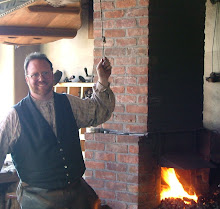 All wooden wheels are not the same. Wheelwrights made them in every shape and size. Wheelbarrow wheels are among the smallest. Cart wheels can be tall and thin while wagon wheels can be thicker and heavier. Two wheels in our collection stand in a class of their own. These are the wheels for the strongest of ox carts. Look at the massive pieces of elm used for the wheel hubs, the ash spokes as thick as your arm, and the wide wrought iron tyre.
All wooden wheels are not the same. Wheelwrights made them in every shape and size. Wheelbarrow wheels are among the smallest. Cart wheels can be tall and thin while wagon wheels can be thicker and heavier. Two wheels in our collection stand in a class of their own. These are the wheels for the strongest of ox carts. Look at the massive pieces of elm used for the wheel hubs, the ash spokes as thick as your arm, and the wide wrought iron tyre. How is a wheel made? The center of the wheel that bears on the axle is called a hub. The hub was often tough, split resistant wood like elm. The hub has a hole for the axle bored through it, and has up to 14 holes for the spokes that connect the hub and the outer part of the wheel. The wooden outside rim is made up from sections of wood called the felloes (often pronounced either fellows or fellys). In the wheels of the early 19th century each felloe was supported by 2 spokes. The whole thing is bound with an iron band called a tyre (tire).
How is a wheel made? The center of the wheel that bears on the axle is called a hub. The hub was often tough, split resistant wood like elm. The hub has a hole for the axle bored through it, and has up to 14 holes for the spokes that connect the hub and the outer part of the wheel. The wooden outside rim is made up from sections of wood called the felloes (often pronounced either fellows or fellys). In the wheels of the early 19th century each felloe was supported by 2 spokes. The whole thing is bound with an iron band called a tyre (tire).These wheels are survivors from an era long gone. The stout ox carts could have been used to haul the heaviest of cargo. An ox cart with wheels like these may have had up to 4 oxen yoked to it and carried a load of several tons. Cooperstown would have received coal and steel deliveries from the nearby Erie Canal using this kind of cart.

Wouldn't it be nice to have the cart that goes with those wheels!
ReplyDeleteI recently bought, at a farm auction, what is called a stud cart. It was used pre-1930's to drive a stallion around to various farms in the area to breed their work horses. The owner would be gone for days at a time in this business of breeding horses.
With a good scrubbing and some axle-grease, it's still in good working condition. I'm using it to train my ox. You can see pictures of my cart and ox on my blog at: http://storybrookeripples.blogspot.com/2010/07/oxcarting_7118.html
Yours is an interesting blog and I am now a follower.
LTD
Very informative! You wouldn't happen to know anyone looking to buy one of these antique ox cart wheels? We have one over 150 yrs old, excellent condition, with original tyres and hand hammered bolts. We can't find any information on the net about their value! We hate to get rid of it, but someone could enjoy it better than us having had it hanging from the rafters of an outbuilding for 20 yrs.
ReplyDeleteIf you have any info please email me!
Cara Bevan
email: NobleD9C@aol.com